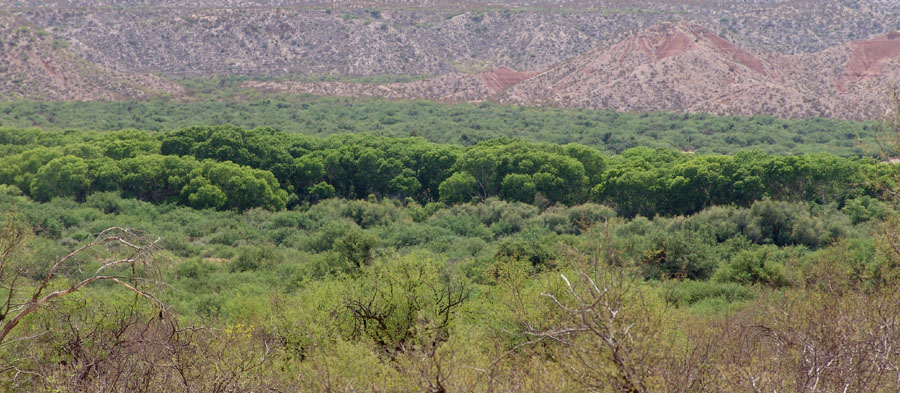Fremont Cottonwood-Gooding Willow Gallery Forest,
sometimes associated with Velvet Mesquite
In the image above, the somewhat brighter-green, higher-canopy trees that run across the center comprise the cottonwood-willow part of the forest, while the lower, darker green trees are mostly velvet mesquite. Image taken near the Three-links Farm along the Middle San Pedro River Watershed, July 6, 2007.
Main Source: Brown, David E., Editor, 1994, Biotic Communities: Southwestern United States and Northwestern Mexico. Salt Lake City: University of Utah Press.
Brown views this biome as one subtype of Tropical-Subtropical Wetlands:
Sonoran Riparian Deciduous Forest and Woodlands
According to Minckley and Brown, "Centered in the Sonoran biotic province are streamside associations of tropic-subtropic subspecies of willow [Salix gooddingi var. variabilis], cottonwood or alamo [Populus fremontii var. macdougalii]", P. diomorpha, and/or Velvet Mesquite [Prosopis veluntina]. Winter deciduous, these biomes are nonetheless subtropical riparian where they are restricted to streams and springs below 1100 to 1200 m elevation in and immediately adjacent to, the Sonoran Desert. While now much reduced in extent, these forests are still represented by impressive examples and may contain individual trees of great size." (p. 169)
Willow and cottonwood forests were, and remain, largely restricted to streams maintained by periodic winter-spring flooding.... As such, southwestern tropic-subtropic examples are largely restricted to the lower Colorado River and Arizona Upland subdividisions of the Sonoran Desert, which possess watersheds of sufficient winter precipitation and hence the spring discharges necessary to support them." (ibid.)
Mesquite "bosques" (Spanish for "woodlands") attain their maximum development on alluvium of old dissected flood plains, especially those laid down at the confluence of major watercourse and their larger tributaries.... Consequently, these higher "secondary" flood plains are commonly 1.5 to 6.0 m above the river channel. (ibid.)
Back to Trees and Shrubs
